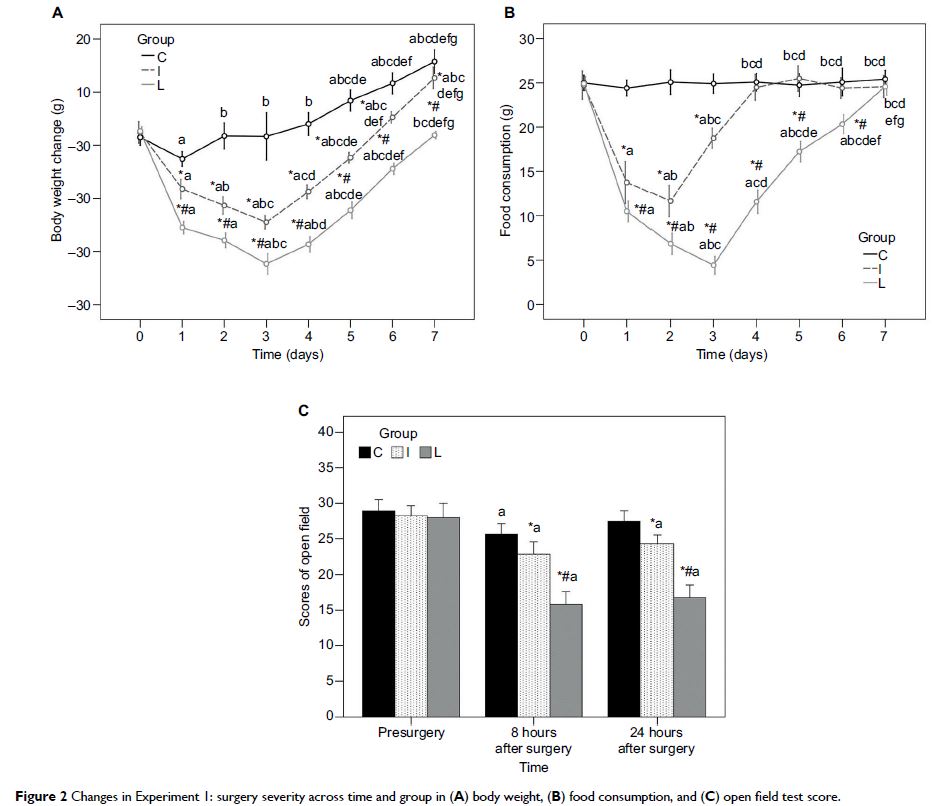9 0 6 7 6
论文已发表
注册即可获取德孚的最新动态
IF 收录期刊
- 2.6 Breast Cancer (Dove Med Press)
- 3.9 Clin Epidemiol
- 3.3 Cancer Manag Res
- 3.9 Infect Drug Resist
- 3.6 Clin Interv Aging
- 4.8 Drug Des Dev Ther
- 2.8 Int J Chronic Obstr
- 8.0 Int J Nanomed
- 2.3 Int J Women's Health
- 3.2 Neuropsych Dis Treat
- 4.0 OncoTargets Ther
- 2.2 Patient Prefer Adher
- 2.8 Ther Clin Risk Manag
- 2.7 J Pain Res
- 3.3 Diabet Metab Synd Ob
- 4.3 Psychol Res Behav Ma
- 3.4 Nat Sci Sleep
- 1.9 Pharmgenomics Pers Med
- 3.5 Risk Manag Healthc Policy
- 4.5 J Inflamm Res
- 2.3 Int J Gen Med
- 4.1 J Hepatocell Carcinoma
- 3.2 J Asthma Allergy
- 2.3 Clin Cosmet Investig Dermatol
- 3.3 J Multidiscip Healthc

不同镇痛深度和腹部创伤严重程度的差异对经历全静脉麻醉的大鼠的应激和恢复的影响
Authors Huang HM, Cao J, Zhu LM, Chen YQ, Lu FD, Cai HW
Received 23 December 2016
Accepted for publication 16 March 2017
Published 12 May 2017 Volume 2017:10 Pages 1143—1153
DOI https://doi.org/10.2147/JPR.S130949
Checked for plagiarism Yes
Review by Single-blind
Peer reviewers approved by Dr Colin Mak
Peer reviewer comments 3
Editor who approved publication: Dr Michael Schatman
Abstract: A number of animal models have been developed to examine the
pathophysiological consequences of surgical procedures, but anesthetic methods,
monitoring, and management measures in these models are very different from those
used in humans. This study was designed to create a rat model of abdominal
surgery using anesthetic methods and perioperative treatment similar to those
used in the clinic and to investigate the effects of different injury
severities and depths of anesthesia and analgesia on surgical stress and
postoperative recovery. Abdominal skin/muscle incision was compared with
exploratory laparotomy in rats under propofol intravenous anesthesia,
accompanied by perioperative measures such as oxygen inhalation, fluid
infusion, warmth, blood gas analysis, and infection prevention. Stress indices
(mean arterial pressure, heart rate, blood glucose, and plasma corticosterone)
were monitored during anesthesia and surgery, and recovery indicators (body
weight, food consumption, and pain) were measured after surgery. In addition,
animals undergoing laparotomy were subjected to low and high dosages of
propofol and sufentanil, in order to examine the relationship between
anesthetic and analgesic depth and stress on recovery. Exploratory laparotomy
induced a greater stress response and caused slower postoperative recovery as
measured than somatic injury. High-dose sufentanil downregulated plasma
corticosterone and improved postoperative recovery more effectively than
high-dose propofol (P <0.05). Taken
together, a rat model of abdominal surgery using anesthetic methods and
perioperative treatment similar to those used in the clinic was successfully
developed. It showed a positive correlation between severity of surgical trauma
and stress response and postoperative recovery and a significant role of
adequate analgesia in reducing surgical stress and improving postoperative
recovery.
Keywords: animal model, injury severity, stress
response, postoperative recovery, analgesic depth, abdominal trauma
